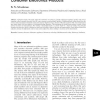Free Online Productivity Tools
i2Speak
i2Symbol
i2OCR
iTex2Img
iWeb2Print
iWeb2Shot
i2Type
iPdf2Split
iPdf2Merge
i2Bopomofo
i2Arabic
i2Style
i2Image
i2PDF
iLatex2Rtf
Sci2ools
PUC
2002
2002
Perceived Similarities and Preferences for Consumer Electronics Products
: A Swedish sample of 36 people judged the similarities of 20 objects, primarily information appliance products and services sometimes called consumer electronics, but also some common non-technological products. Multidimensional scaling showed that the choices of the participants were formed as three main regions: telephone services, luxuries of life and necessities of life. Axes interpretation gave similar results, with the addition of a biology/technology dimension. The participants also ranked these products in terms of their personal necessity and entertainment. The rankings corresponded largely to a pattern found for a larger US sample. One particular exception was education, which in Sweden was seen more favourably in terms of necessity and entertainment. Cluster analysis showed that education and type of employment could to some extent explain the choices relating to necessity and of entertainment.
| Added | 23 Dec 2010 |
| Updated | 23 Dec 2010 |
| Type | Journal |
| Year | 2002 |
| Where | PUC |
| Authors | B. N. Schenkman |
Comments (0)

